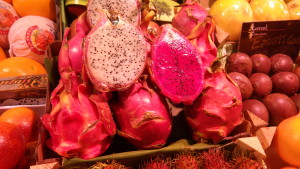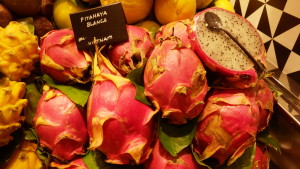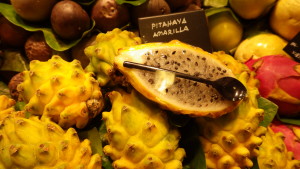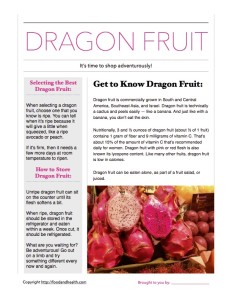 When I travel, I love to check out what the locals are eating.
When I travel, I love to check out what the locals are eating.
One way to do this is by visiting grocery stores and farmers’ markets in different cities and countries. I especially enjoy looking at the unique fruits and vegetables that I don’t usually find near my home.
Here are a few photos from a market we visited in Spain. Do you know what the top picture features? Hint: it’s a fruit.
The answer is pitahaya, also known as pitaya. In the United States, it’s commonly called dragon Fruit, and at this market you could get one for a little over $6. There, these fruits are often sliced in half and sold with a spoon for an easy snack on the go. There were a couple varieties and all were beautiful — red ones with white or pink or even red flesh or a yellow variety that had white flesh.
And in case you were wondering, yes, I bought one. I was told that the ones with pink flesh were sweeter, but I didn’t get a chance to compare them. My purchase tasted like a combination of a melon and a kiwi, and the black seeds provided a nice crunch.
 So I decided to do a little research about this amazing fruit. Want to see what I found?
So I decided to do a little research about this amazing fruit. Want to see what I found?
The sign at the Spanish market said that their fruit came from Vietnam. Dragon fruit is commercially grown in South and Central America, Southeast Asia, and Israel. Dragon fruit is technically a cactus and peels easily — like a banana. And just like with a banana, you don’t eat the skin.
Nutritionally, 3 ½ ounces of dragon fruit (about ½ of 1 fruit) contains 1 gram of fiber and 9 milligrams of vitamin C. That’s about 15% of the amount of vitamin C that’s recommended daily for women. Dragon fruit with pink or red flesh is also known its lycopene content. Like many other fruits, dragon fruit is low in calories.
When selecting a dragon fruit, choose one that you know is ripe. You can tell when it’s ripe because it will give a little when squeezed, like a ripe avocado or peach. If it’s firm, then it needs a few more days at room temperature to ripen. When ripe, dragon fruit should be stored in the refrigerator and eaten within a week. Once cut, it should be refrigerated. Dragon fruit can be eaten alone, as part of a fruit salad, or juiced.
These certainly gave us nice taste memories from our trip.
 Now, am I suggesting that you go out and spend $6 for a piece of fruit every day? Not at all.
Now, am I suggesting that you go out and spend $6 for a piece of fruit every day? Not at all.
Instead, I like to encourage people to be adventurous with food. Go out on a limb and try something different every now and again. Everyone knows that we should be eating more fruits and vegetables, but the ordinary bananas, apples, green beans, and broccoli can get boring. No wonder it’s hard for people to get the 9 servings of fruits and vegetables a day that are recommended by the Dietary Guidelines for Americans. If you’re going to fill half your plate with fruits and vegetables, you’ll have to do something about variety. Occasionally, try something fun, like dragon fruit.
Oh, and if you’re a health educator, consider planning a group trip to a local grocery store. People can look for something that the other members of the group haven’t tried before. Purchasing and/or sharing some unique fruits and vegetables with your clients or students can expand horizons, and who knows, maybe it’ll get them to eat more fruits and vegetables.
Wouldn’t that be great?
By Cheryle Jones Syracuse, MS, Professor Emeritus at The Ohio State University
And as a little bonus, here’s a free dragon fruit fact sheet, just for you!
Remember, there are lots of great materials in the Nutrition Education Store!






